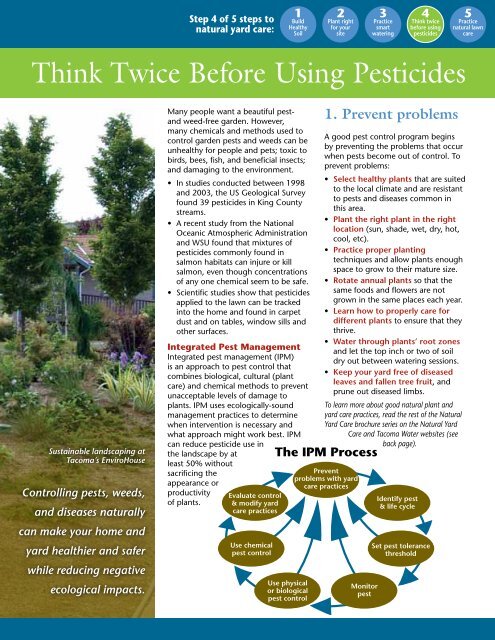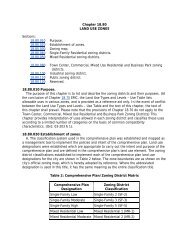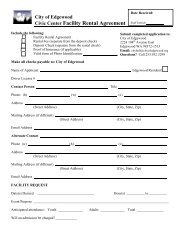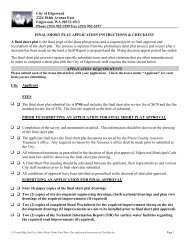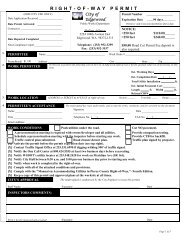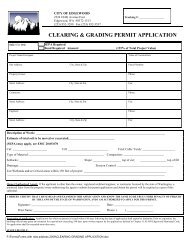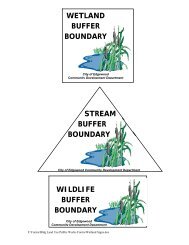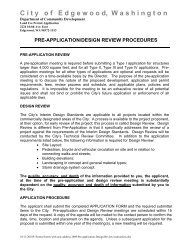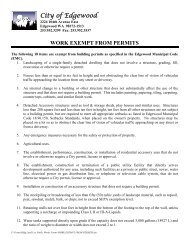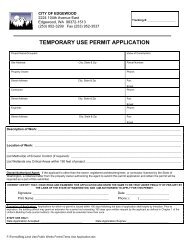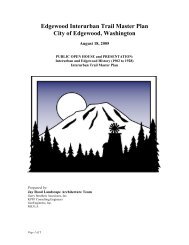Integrated Pest Management - City Of Buckley
Integrated Pest Management - City Of Buckley
Integrated Pest Management - City Of Buckley
You also want an ePaper? Increase the reach of your titles
YUMPU automatically turns print PDFs into web optimized ePapers that Google loves.
Step 4 of 5 steps to<br />
natural yard care:<br />
1<br />
Build<br />
Healthy<br />
Soil<br />
2<br />
Plant right<br />
for your<br />
site<br />
3<br />
Practice<br />
smart<br />
watering<br />
4<br />
Think twice<br />
before using<br />
pesticides<br />
5<br />
Practice<br />
natural lawn<br />
care<br />
Think Twice Before Using <strong>Pest</strong>icides<br />
Sustainable landscaping at<br />
Tacoma’s EnviroHouse<br />
Controlling pests, weeds,<br />
and diseases naturally<br />
can make your home and<br />
yard healthier and safer<br />
while reducing negative<br />
ecological impacts.<br />
Many people want a beautiful pestand<br />
weed-free garden. However,<br />
many chemicals and methods used to<br />
control garden pests and weeds can be<br />
unhealthy for people and pets; toxic to<br />
birds, bees, fish, and beneficial insects;<br />
and damaging to the environment.<br />
• In studies conducted between 1998<br />
and 2003, the US Geological Survey<br />
found 39 pesticides in King County<br />
streams.<br />
• A recent study from the National<br />
Oceanic Atmospheric Administration<br />
and WSU found that mixtures of<br />
pesticides commonly found in<br />
salmon habitats can injure or kill<br />
salmon, even though concentrations<br />
of any one chemical seem to be safe.<br />
• Scientific studies show that pesticides<br />
applied to the lawn can be tracked<br />
into the home and found in carpet<br />
dust and on tables, window sills and<br />
other surfaces.<br />
<strong>Integrated</strong> <strong>Pest</strong> <strong>Management</strong><br />
<strong>Integrated</strong> pest management (IPM)<br />
is an approach to pest control that<br />
combines biological, cultural (plant<br />
care) and chemical methods to prevent<br />
unacceptable levels of damage to<br />
plants. IPM uses ecologically-sound<br />
management practices to determine<br />
when intervention is necessary and<br />
what approach might work best. IPM<br />
can reduce pesticide use in<br />
the landscape by at<br />
least 50% without<br />
sacrificing the<br />
appearance or<br />
productivity<br />
of plants.<br />
Evaluate control<br />
& modify yard<br />
care practices<br />
Use chemical<br />
pest control<br />
The IPM Process<br />
Use physical<br />
or biological<br />
pest control<br />
1. Prevent problems<br />
A good pest control program begins<br />
by preventing the problems that occur<br />
when pests become out of control. To<br />
prevent problems:<br />
• Select healthy plants that are suited<br />
to the local climate and are resistant<br />
to pests and diseases common in<br />
this area.<br />
• Plant the right plant in the right<br />
location (sun, shade, wet, dry, hot,<br />
cool, etc).<br />
• Practice proper planting<br />
techniques and allow plants enough<br />
space to grow to their mature size.<br />
• Rotate annual plants so that the<br />
same foods and flowers are not<br />
grown in the same places each year.<br />
• Learn how to properly care for<br />
different plants to ensure that they<br />
thrive.<br />
• Water through plants’ root zones<br />
and let the top inch or two of soil<br />
dry out between watering sessions.<br />
• Keep your yard free of diseased<br />
leaves and fallen tree fruit, and<br />
prune out diseased limbs.<br />
To learn more about good natural plant and<br />
yard care practices, read the rest of the Natural<br />
Yard Care brochure series on the Natural Yard<br />
Care and Tacoma Water websites (see<br />
back page).<br />
Prevent<br />
problems with yard<br />
care practices<br />
Monitor<br />
pest<br />
Identify pest<br />
& life cycle<br />
Set pest tolerance<br />
threshold
Photo: Washington State University<br />
Aphids suck nutrients and<br />
moisture from plants.<br />
Photo: Oregon State University<br />
Root weevil adults eat<br />
notches along leaf edges.<br />
Larvae feed on roots.<br />
Types of <strong>Pest</strong> Controls<br />
Cultural: Improve plant health and decrease the impact of<br />
pests by improving soil; providing adequate light, water,<br />
and nutrients; and planting complementary plants.<br />
Mechanical: Use traps, barriers, hand picking, and even<br />
sounds to control pests.<br />
Biological: Use beneficial insects and natural predators to<br />
control pests.<br />
Chemical: Use chemicals to kill pests only as a last resort.<br />
2. Inspect and identify pests<br />
Regularly inspect your yard for pests to find problems<br />
while they are still small and easier to manage.<br />
When you find a pest, you need to properly identify<br />
the weed, insect or disease so you can determine what<br />
action to take. Most insects are beneficial or non-harmful<br />
and what initially looks like a pest may simply be a<br />
beneficial insect in another life stage.<br />
Washington State University’s Hortsense website at<br />
http://pep.wsu.edu/hortsense and other resources<br />
listed on the back of this brochure can be useful for<br />
identifying specific weeds, insects, and diseases.<br />
3. Set pest tolerance thresholds<br />
After you identify a pest, set tolerance thresholds<br />
and management objectives. Consider the following<br />
questions:<br />
What are your objectives in managing pests?<br />
Objectives may include protecting children’s and/or pet<br />
health from pest problems and excessive or unnecessary<br />
pesticide use; maintaining an aesthetically-pleasing<br />
yard; or protecting wildlife and water resources from<br />
pesticides.<br />
How much damage or how many weeds can you<br />
tolerate? Is it OK if damage is confined to one plant in<br />
your yard? Is the pest damaging or threatening anything<br />
else in your yard? The answers to these questions<br />
depend on the specific insect, disease, or weed you are<br />
managing. For example, you may be able to tolerate<br />
a few aphids on your roses, but decide to spray them<br />
with an insecticidal soap if they get to a too damaging<br />
level. Researching recommended action thresholds for<br />
particular pests is important.<br />
Can a plant outgrow the damage you have found?<br />
Sometimes no intervention is necessary and nature will<br />
correct the problem.<br />
What is the natural threshold for a specific pest?<br />
Many pest populations reach a peak and then naturally<br />
level off or decline, making control after this peak<br />
unnecessary.<br />
4. Monitor pests<br />
Monitor pest levels and note whether the pest:<br />
• Continues to cause a problem;<br />
• Increases or decreases in number; or<br />
• Spreads to other plants.<br />
When the pest population exceeds your tolerance<br />
threshold, take action.<br />
Monitoring can help you learn where the pest is in its life<br />
cycle so that you can make wise control decisions. Some<br />
pests are more susceptible to specific control measures<br />
at particular points in their life cycle. Specific weather<br />
conditions might also influence the pest. Simply waiting<br />
for a weather change may be the only control you need.<br />
5. Use physical, mechanical,<br />
and biological controls<br />
Many pests can be kept away by using traps or barriers,<br />
or by physically removing them and infected plant parts.<br />
• Handpicking can be effective for large pests like<br />
cabbage loopers and slugs.<br />
• Pruning out infestations can be effective on a small<br />
scale.<br />
• Washing aphids off the underside of leaves can<br />
reduce damage.<br />
• Barriers like floating row covers are lightweight<br />
fabrics that let light, air, and water reach plants while<br />
keeping pests away.<br />
• Long-handled weed pullers can be used to control<br />
dandelions and other tap-rooted weeds in lawns or<br />
landscape beds.
Photo: Washington State University<br />
Photo: Oregon State University<br />
Photo: Washington State University<br />
Photo: Washington State University<br />
Ladybugs feed on soft-bodied<br />
insects such as aphids,<br />
mealybugs, scale insects, and<br />
spider mites.<br />
Lacewings eat aphids, scales,<br />
mites, caterpillars, and other<br />
pests.<br />
Ground beetles eat slug eggs<br />
and babies and other soildwelling<br />
pests.<br />
Yellow jackets are<br />
predators of many<br />
garden pests.<br />
Beneficial insects<br />
Healthy landscapes and gardens have natural<br />
populations of beneficial organisms, including beneficial<br />
insects, parasites and pathogens that naturally target<br />
pests. Beneficial insects may include spiders, mites,<br />
centipedes, nematodes, lacewings, lady beetles<br />
(ladybugs), rove beetles, and parasitic wasps. Think<br />
about managing for beneficial species, instead of against<br />
the pests.<br />
Plan your garden to feed beneficial insects:<br />
• Choose a variety of plants that will bloom as many<br />
months of the year as possible in order to provide a<br />
good pollen source for beneficial insects when pest<br />
populations are low.<br />
• Plant plants in the cabbage, carrot and sunflower<br />
family.<br />
• Leave leaf debris in beds for beneficial insects to<br />
overwinter (remove any diseased leaves).<br />
Finally, don’t forget the birds – trees, shrubs with berries,<br />
birdhouses, and water features all encourage birds,<br />
which also eat insects, to visit your yard.<br />
6. Use least toxic pesticides<br />
“Least toxic” pesticides have a low toxicity or degrade<br />
quickly when exposed to sunlight or soil. However, even<br />
these pesticides can be toxic to beneficial garden life,<br />
people, pets, and other animals. You should take care to<br />
keep them out of streams, lakes and Puget Sound.<br />
Biocontrols are biological agents that control pests.<br />
Although it is unlikely they will provide 100% control<br />
of a pest, they can help to drop pest numbers below<br />
threshold levels.<br />
• Bacillus thuringiensis (Bt) is a commonly available<br />
bacteria that poisons caterpillar pests, including<br />
cutworms, armyworms, tent caterpillars, cabbage<br />
loopers, and corn earworms.<br />
• Predatory nematodes kill a variety of pests including<br />
cutworms, armyworms, root weevil larvae, root<br />
maggots, and cranefly larvae. Moisture must be<br />
adequate and soil temperatures usually above 55º F<br />
for nematodes to be effective.<br />
• Spinosad is a microbial insecticide that kills many<br />
caterpillar, beetle, and thrips pests, including leaf<br />
miners. It is only active if ingested or contacted while<br />
in liquid form, so it has little effect on most beneficial<br />
species and mammals. It is toxic to shellfish and fish.<br />
Botanicals are plant-derived pesticides that degrade<br />
quickly in sunlight or soil.<br />
• Neem oil kills and disrupts feeding and mating of<br />
many insects, including some beneficials. Neem oil<br />
is also used as a fungicide that is less toxic to people,<br />
animals, birds, and fish.<br />
• Pyrethrums, ryania, and sabadilla are plant-derived<br />
compounds that kill many pests and degrade quickly<br />
in sun and soil. They are toxic to people, fish, and<br />
other mammals.<br />
Other less toxic products:<br />
• Horticultural oils smother mites, aphids, scales, leaf<br />
miners and other pests.<br />
• Horticultural soaps dry out aphids, white flies, and<br />
other soft-bodied insects.<br />
• Sulfur controls many fungal diseases such as scab,<br />
rust, and powdery mildew. It can be mixed with lime<br />
for greater efficacy.<br />
• Iron phosphate is a less toxic alternative to<br />
metaldehyde and not as hazardous to pets<br />
• Clove oil and acetic acid (vinegar and other<br />
solutions) burn weed foliage. Repeat applications may<br />
be required for effective weed control.<br />
Garden centers and nurseries in the Pierce County<br />
Natural Yard Care Garden Center program regularly<br />
stock less toxic alternatives. A list of garden centers can<br />
be found at www.tpchd.org/naturalyardcare.
Use synthetic pesticides as a last resort when less<br />
toxic measures do not control the pest. Spray only the<br />
pest or weeds rather than broadcasting the pesticide.<br />
Applying products such as weed and feed to the<br />
entire lawn or combination insecticides and fungicides<br />
is often overkill and uses chemicals where they are<br />
not needed. Also avoid prescheduled sprays that are<br />
calendar-based. Instead, inspect for pest damage and<br />
use least toxic methods based on actual problems.<br />
Use pesticides correctly<br />
• Check the product label to be sure both the target<br />
plant and pest are listed.<br />
• Read the label and follow label directions exactly:<br />
the label is the law. The pesticide label provides<br />
information about proper handling, potential<br />
risks of the product, and instructions on how to<br />
minimize those risks. Even low-risk pesticides can be<br />
dangerous when mishandled.<br />
• Buy only as much as you need. Unused pesticides<br />
are dangerous to store or dispose.<br />
• Choose ready-to-use products which are safer to<br />
handle instead of more toxic concentrates that<br />
require mixing.<br />
• Remember, broad-spectrum pesticides like diazinon,<br />
chlorpyrifos, malathion, and carbaryl kill natural<br />
predators as well as pests.<br />
7. Evaluate the process<br />
Evaluate how your pest control strategy worked. Keep<br />
written notes of the problem (when it developed, the<br />
weather conditions, severity of the problem) and think<br />
about strategies to avoid it in the future. Ask yourself:<br />
• Could I have identified the problem earlier with<br />
better inspection and then handled the problem<br />
culturally or with a less-toxic pesticide?<br />
• Was the pest managed satisfactorily?<br />
• Were there any unintended side effects?<br />
• What will I do in the future to manage this<br />
situation?<br />
• Has this plant had a problem before? Do I need to<br />
replace it with a more resistant variety or species, or<br />
do I need to move it?<br />
IPM is not a one-size-fits-all recipe for pest control,<br />
but provides a framework for dealing with pests in the<br />
home landscape. Remember that as pests drop below<br />
their threshold level, return to the beginning of the<br />
IPM process.<br />
Resources<br />
Washington State University: Hortsense http://pep.wsu.edu/hortsense/ and <strong>Pest</strong>sense http://pep.wsu.edu/pestsense/<br />
Washington Toxics Coalition: www.watoxics.org/<br />
National <strong>Pest</strong>icide Information Center: http://npic.orst.edu/<br />
Washington State Noxious Weed Control Board weed list: www.nwcb.wa.gov/weed_list/weed_list.htm<br />
Natural Yard Care Program at the Tacoma-Pierce County Health Department: www.tpchd.org/NaturalYardCare<br />
Water Conservation Program, Tacoma Water: www.tacomawater.com<br />
USGS, <strong>Pest</strong>icides Detected in Urban Streams in King County, Washington 1998-2003:<br />
http://wa.water.usgs.gov/projects/urbanpest<br />
Thanks to the Washington State Department of Ecology for contributing funding for this publication (Grant No. G0700257).<br />
542 6/09


